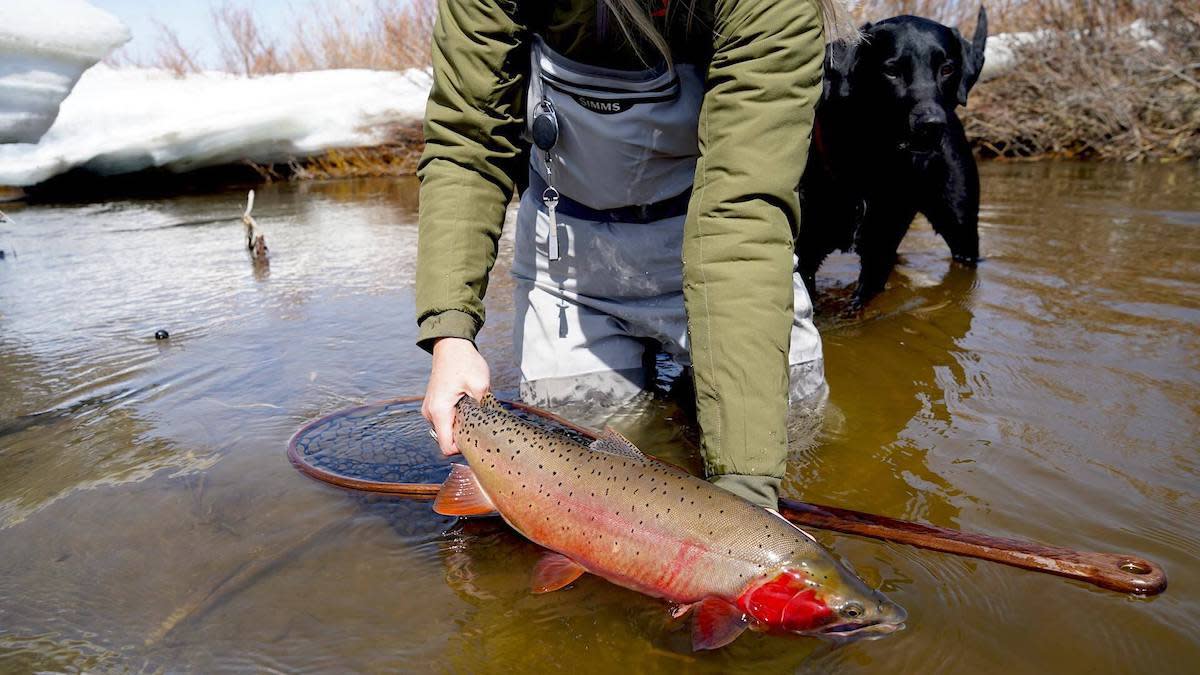
“Big water, big fish” is a maxim I’ve smiled and nodded at politely for more than a decade. It’s not that I don’t believe big fish live in big water-have you seen the trout they pull out of Pyramid Lake!? But I take mild offense to any suggestion that inverse of the statement implies: “Small fish live in small water.”
I’ll be upfront, I shun most big water and the crowds who flood there like snowmelt. And it’s not only solitude and willing fish that send me up drainages choked with brush. The possibility of catching small-stream trophies pulls me higher.
In most streams where the average trout is somewhere between 7 and 8 inches, a 16-incher is a real monster. A wild or native trout of that size in a little creek will challenge any angler to hook and land, and make every one pause to admire the flanks, spots, and teeth on the lower jaw. On a small tributary, such a fish will leave you wondering if you should wade so casually across the riffles.
No matter if you toss spinners, strip streamers, or soak worms, here are three things you need to know if you’re going to catch big fish in tiny water.
Know the Food Some anglers associate small creeks with somewhat sterile water where fish will eat a crumpled piece of paper if it floated by. While this may be true in some cases, plenty of other waters host prolific bug life.
Spend 30 minutes turning over rocks in any healthy Appalachian brook trout stream and you’ll find an array of stonefly nymphs. Good cutthroat streams in the Rockies will seasonally see boulders carpeted in caddis. But it’s the most energy-rich bugs—grasshoppers, drakes, salmonflies, and golden stones—that are the real big fish makers. Streams with healthy populations of large bugs mean fish can gorge themselves and grow faster and fatter than their cousins without access to so many calories.
Hatches on small streams seem to rarely follow the schedule of the river they flow into. Green drakes are traditionally a late evening and night hatch on the famed Penns Creek of Pennsylvania, but its tributaries see the giant mayflies pop in the early to mid-afternoon, bringing large trout to the surface in the light of day. Don’t wait for the evening to go fish.
With good connectivity to a larger waterway, really big fish often show up in small water to feed or breed. While you shouldn’t fish to trout on redds, if you’re catching a diversity of age classes as you work up a creek, you can assume some older fish are bellying up to the buffet. It can sometimes be worthwhile to try some leech, sculpin, or other streamer patterns to trigger carnivorous fish. Also, look for signs of mice along the shore like tracks or droppings. One 18-inch brown I pulled from a brookie stream (and ate to save some natives) had a mouse filling its belly. The whiskers were still stiff.
Know the Depth Fish need places to hide to survive. That might seem like common sense, but many anglers don’t do their homework when it comes to scouting creeks. If you suspect big fish could be around, take the time to walk a mile or two of stream before, during, or after fishing. This is a great activity when the water is too low or hot to ethically fish for trout. Peer into pools to investigate the depth. Check for cutbanks, plunge pools, springs, submerged boulders, tree shade, root structure, logjams, and other woody debris. Big fish often hold in the best habitat and deepest water available in otherwise shallow streams.
Even in streams you can jump across, there will often be one or two pools with water 4 to 6 feet deep. That’s more than enough depth to make a chunky cutthroat or brookie feel safe.
Know the Weather After the high water of spring, summer doldrums send big trout into the most secretive, tucked-away corners of a stream—or out of it entirely. But a July or August thunderstorm can change everything. I’ve caught multiple native brook trout in the 13- to 16-inch range and wild brown trout over a pound after a summer thunderstorm swelled a small creek. Usually, these are my biggest fish of the year in these tributaries.
Large trout feel safest when flows are high and off-color. After weeks without significant precipitation these fish will often become mostly nocturnal, eating one or two large meals every day in order to conserve energy. But with the arrival of more water, these fish can lose their inhibitions and eat regularly in the higher flows.
You need to be quick in reaching the stream after these weather events. Small streams shed water faster than rivers. It’s during the drop in flow rate that the best fishing occurs. Streamer and spinner anglers know that a little stain in the water is big fish feeding time. Take a page out of their book to find a small stream giant.
Feature image via Sam Lungren




